Team Report: Reflecting on Team Skills, Learning & Performance
VerifiedAdded on 2023/04/03
|19
|5128
|383
Report
AI Summary
This team report reflects on the learning journey and development of team skills and performance, identifying key issues such as psychological contracting, action learning, growth mindset, feedback, double-loop learning, conflict management, espoused theories, theories in use, emotional intelligence, and leadership. The report applies advanced-level theories and frameworks with practical examples of the team's development from a mere group to a high-performing team. It discusses the five stages of team development and emphasizes the importance of team members' actions, behaviors, and attitudes in achieving organizational goals. The report also highlights the significance of effective communication, continuous learning, and adapting to the organization's culture and ethics for enhancing team performance and efficiency.
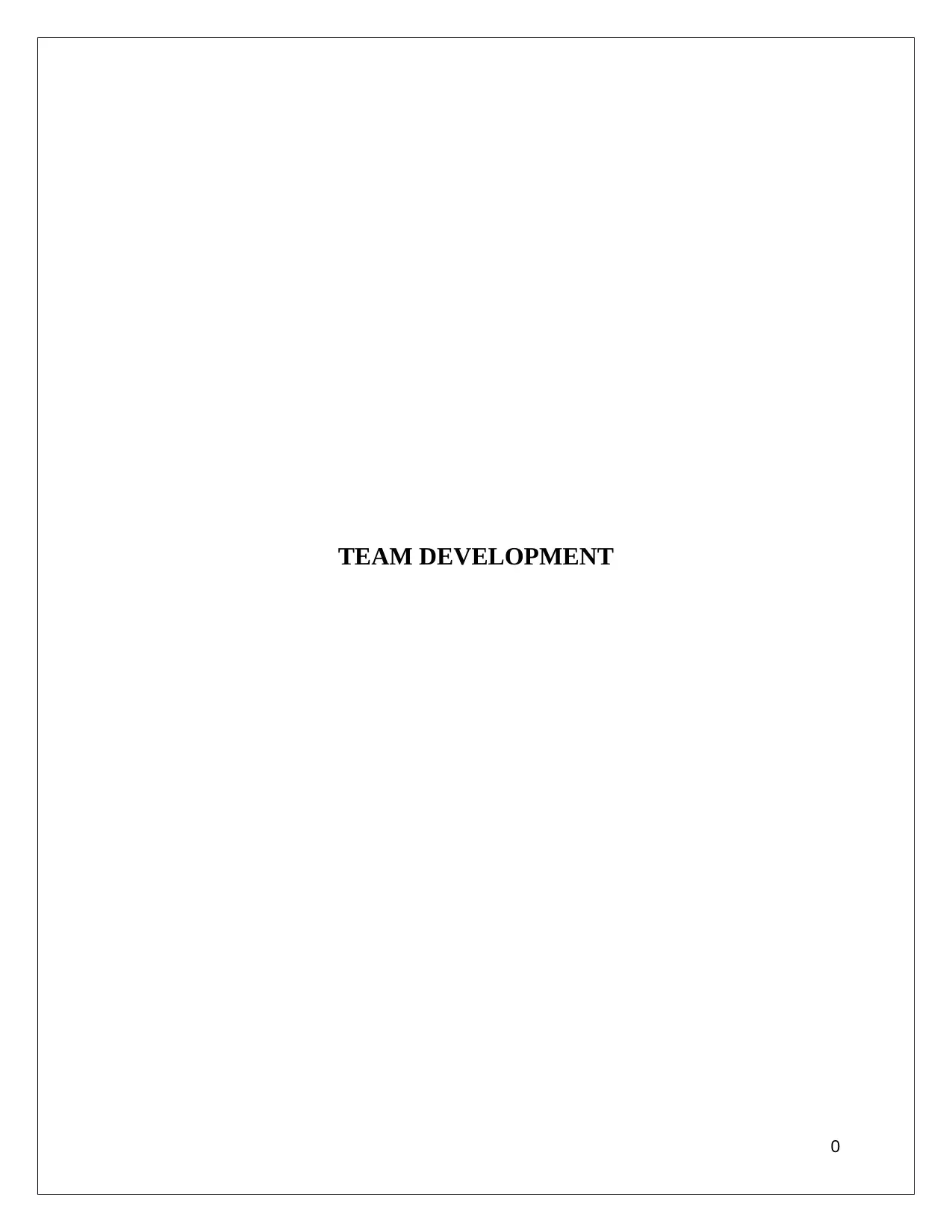
TEAM DEVELOPMENT
0
0
Paraphrase This Document
Need a fresh take? Get an instant paraphrase of this document with our AI Paraphraser
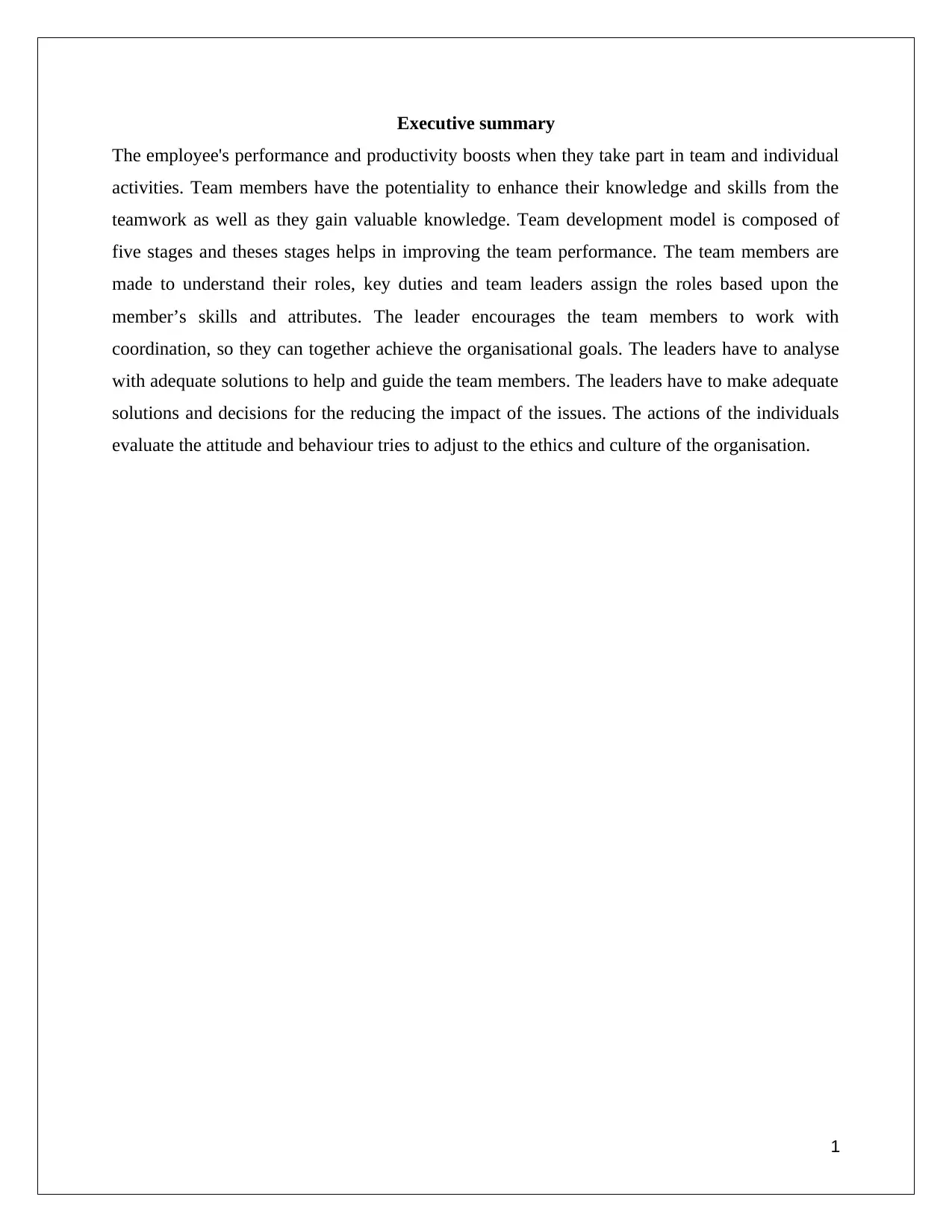
Executive summary
The employee's performance and productivity boosts when they take part in team and individual
activities. Team members have the potentiality to enhance their knowledge and skills from the
teamwork as well as they gain valuable knowledge. Team development model is composed of
five stages and theses stages helps in improving the team performance. The team members are
made to understand their roles, key duties and team leaders assign the roles based upon the
member’s skills and attributes. The leader encourages the team members to work with
coordination, so they can together achieve the organisational goals. The leaders have to analyse
with adequate solutions to help and guide the team members. The leaders have to make adequate
solutions and decisions for the reducing the impact of the issues. The actions of the individuals
evaluate the attitude and behaviour tries to adjust to the ethics and culture of the organisation.
1
The employee's performance and productivity boosts when they take part in team and individual
activities. Team members have the potentiality to enhance their knowledge and skills from the
teamwork as well as they gain valuable knowledge. Team development model is composed of
five stages and theses stages helps in improving the team performance. The team members are
made to understand their roles, key duties and team leaders assign the roles based upon the
member’s skills and attributes. The leader encourages the team members to work with
coordination, so they can together achieve the organisational goals. The leaders have to analyse
with adequate solutions to help and guide the team members. The leaders have to make adequate
solutions and decisions for the reducing the impact of the issues. The actions of the individuals
evaluate the attitude and behaviour tries to adjust to the ethics and culture of the organisation.
1
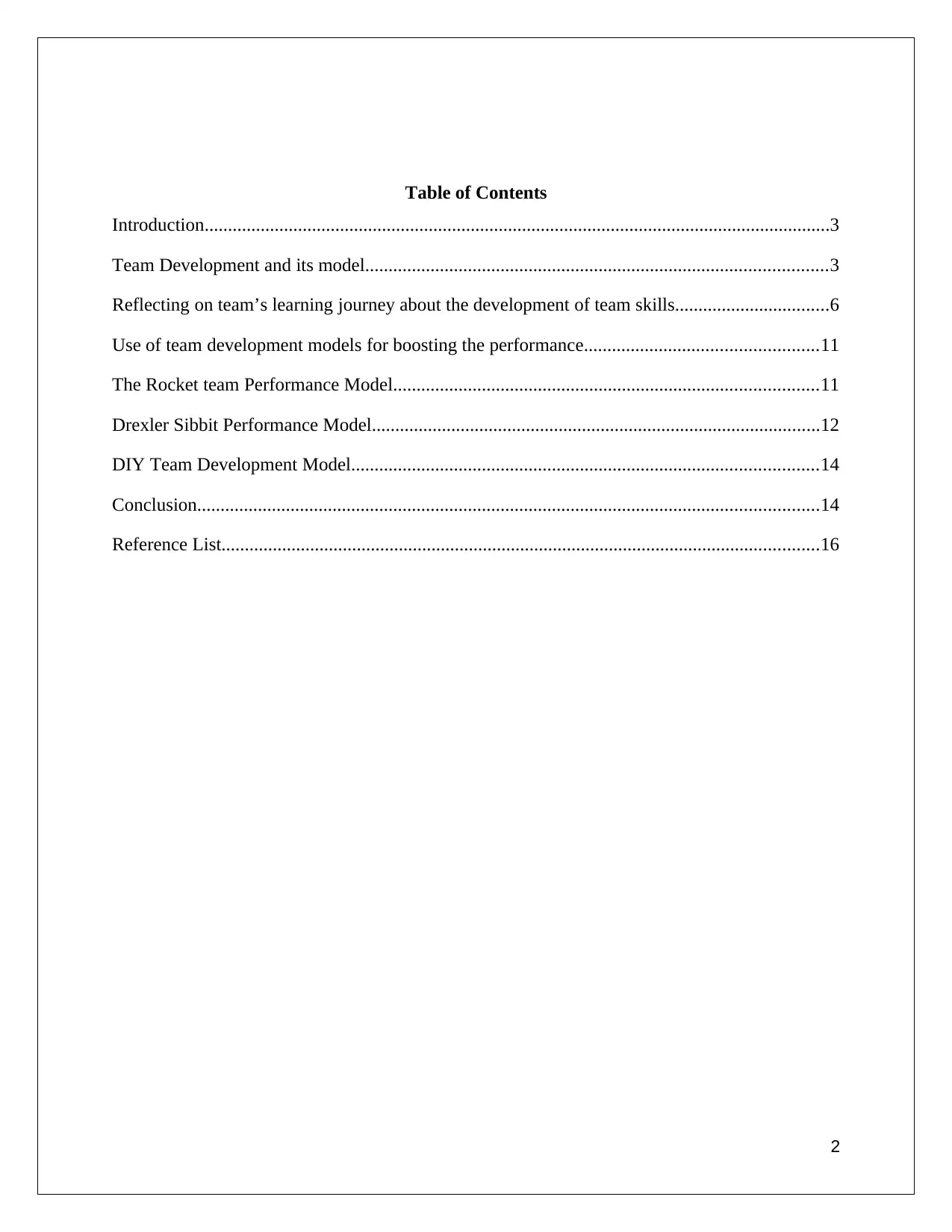
Table of Contents
Introduction......................................................................................................................................3
Team Development and its model...................................................................................................3
Reflecting on team’s learning journey about the development of team skills.................................6
Use of team development models for boosting the performance..................................................11
The Rocket team Performance Model...........................................................................................11
Drexler Sibbit Performance Model................................................................................................12
DIY Team Development Model....................................................................................................14
Conclusion.....................................................................................................................................14
Reference List................................................................................................................................16
2
Introduction......................................................................................................................................3
Team Development and its model...................................................................................................3
Reflecting on team’s learning journey about the development of team skills.................................6
Use of team development models for boosting the performance..................................................11
The Rocket team Performance Model...........................................................................................11
Drexler Sibbit Performance Model................................................................................................12
DIY Team Development Model....................................................................................................14
Conclusion.....................................................................................................................................14
Reference List................................................................................................................................16
2
⊘ This is a preview!⊘
Do you want full access?
Subscribe today to unlock all pages.

Trusted by 1+ million students worldwide

Introduction
Teams are becoming a crucial key for the business organisations in order to sustain in the
corporate world. Teams help the business organisations to achieve the desired goals and
objectives. Teams have the capability to immediately organise, disperse, amass and relocate.
They are also an effective aspect of employee’s motivations. The employee's performance and
productivity increases when they participate in team and group activities. An individual also
enhances the skills and attributes through team or group work. It is essential for the team
members to possess certain skills and traits in order to contribute to the team as well as perform
the assigned role effectively. The study shed lights of effectiveness and importance of team
development and how it helps an individual to acquire as well as enhance skills and attributes.
This study also discusses about several models and theories that are being used and adopted in
team to increase the performance and productivity.
Team Development and its model
The team leaders want to increase the efficiency and performance of the team as well as achieve
the goal before hand. It is essential that every team members contribute to the team through their
performance, productivity and actions. As per the view of Woodcock (2017), team member’s
action, behaviour and attitude create a huge impact on the team's performance. I have
participated in various group activities and the experience gained from those group activities is
very valuable and crucial for my future. I have acquired new skills through the group activities as
well as enhanced my existing skills. I have understood how team operates and how the team can
increase the efficiency and performance of the organisation. I have become skilled eventually
and experienced enough to lead and manage a team in a business firm. As opined by Shuffler et
al. (2018), the experienced that I had acquired from the group activities has helped me to manage
my team at the workplace.
According to my opinion, leaders must try to adopt different team development models and
theories to increase the team’s efficiency and performance. As suggested by Lacerenza et al.
(2018), the team development mainly focuses on improving the team member’s performance by
keeping them motivated. Team members are also able to enhance their skills and knowledge
from the teamwork as well as they gain valuable knowledge. Team development model is
3
Teams are becoming a crucial key for the business organisations in order to sustain in the
corporate world. Teams help the business organisations to achieve the desired goals and
objectives. Teams have the capability to immediately organise, disperse, amass and relocate.
They are also an effective aspect of employee’s motivations. The employee's performance and
productivity increases when they participate in team and group activities. An individual also
enhances the skills and attributes through team or group work. It is essential for the team
members to possess certain skills and traits in order to contribute to the team as well as perform
the assigned role effectively. The study shed lights of effectiveness and importance of team
development and how it helps an individual to acquire as well as enhance skills and attributes.
This study also discusses about several models and theories that are being used and adopted in
team to increase the performance and productivity.
Team Development and its model
The team leaders want to increase the efficiency and performance of the team as well as achieve
the goal before hand. It is essential that every team members contribute to the team through their
performance, productivity and actions. As per the view of Woodcock (2017), team member’s
action, behaviour and attitude create a huge impact on the team's performance. I have
participated in various group activities and the experience gained from those group activities is
very valuable and crucial for my future. I have acquired new skills through the group activities as
well as enhanced my existing skills. I have understood how team operates and how the team can
increase the efficiency and performance of the organisation. I have become skilled eventually
and experienced enough to lead and manage a team in a business firm. As opined by Shuffler et
al. (2018), the experienced that I had acquired from the group activities has helped me to manage
my team at the workplace.
According to my opinion, leaders must try to adopt different team development models and
theories to increase the team’s efficiency and performance. As suggested by Lacerenza et al.
(2018), the team development mainly focuses on improving the team member’s performance by
keeping them motivated. Team members are also able to enhance their skills and knowledge
from the teamwork as well as they gain valuable knowledge. Team development model is
3
Paraphrase This Document
Need a fresh take? Get an instant paraphrase of this document with our AI Paraphraser

composed of five stages and theses stages helps in improving the team performance. The stages
are:
Figure 1: Team development model
(Source: Reyes et al. 2018)
Forming Stage
This is the first stage of team development where the team members discuss their backgrounds,
interests and skills. The team is formed to work together, with coordination and cooperation; so
that they can achieve the shared common goal or objective of the organisation. At this stage, the
team members needs to set a timeline for the goals and they need to focus on achieving the goals
before hand. As per the view of Reyes et al. (2018), the leaders set some ground rules that every
team members as well as the leader has to follow in order to perform the role effectively and
efficiently. The team members chose the role or the team leaders assign the role based upon the
member’s skills and attributes. It is important for every team member to develop an
understanding and relationship with other members in order to understand their role. This stage
is more focused upon people rather than work. A friendly environment is needed so that the team
members could perform their role efficiently and avoid any kind of conflict or chaos.
Storming Stage
4
are:
Figure 1: Team development model
(Source: Reyes et al. 2018)
Forming Stage
This is the first stage of team development where the team members discuss their backgrounds,
interests and skills. The team is formed to work together, with coordination and cooperation; so
that they can achieve the shared common goal or objective of the organisation. At this stage, the
team members needs to set a timeline for the goals and they need to focus on achieving the goals
before hand. As per the view of Reyes et al. (2018), the leaders set some ground rules that every
team members as well as the leader has to follow in order to perform the role effectively and
efficiently. The team members chose the role or the team leaders assign the role based upon the
member’s skills and attributes. It is important for every team member to develop an
understanding and relationship with other members in order to understand their role. This stage
is more focused upon people rather than work. A friendly environment is needed so that the team
members could perform their role efficiently and avoid any kind of conflict or chaos.
Storming Stage
4
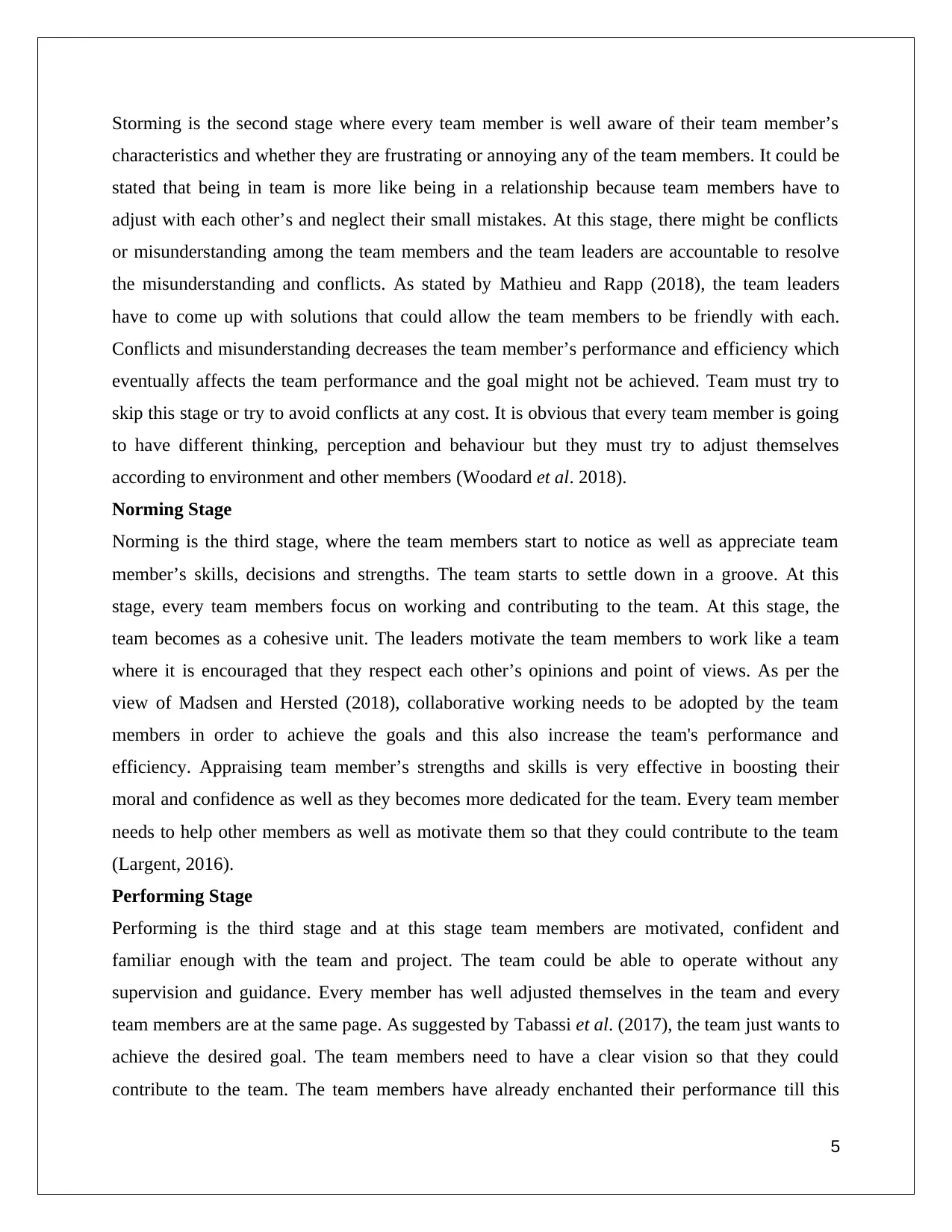
Storming is the second stage where every team member is well aware of their team member’s
characteristics and whether they are frustrating or annoying any of the team members. It could be
stated that being in team is more like being in a relationship because team members have to
adjust with each other’s and neglect their small mistakes. At this stage, there might be conflicts
or misunderstanding among the team members and the team leaders are accountable to resolve
the misunderstanding and conflicts. As stated by Mathieu and Rapp (2018), the team leaders
have to come up with solutions that could allow the team members to be friendly with each.
Conflicts and misunderstanding decreases the team member’s performance and efficiency which
eventually affects the team performance and the goal might not be achieved. Team must try to
skip this stage or try to avoid conflicts at any cost. It is obvious that every team member is going
to have different thinking, perception and behaviour but they must try to adjust themselves
according to environment and other members (Woodard et al. 2018).
Norming Stage
Norming is the third stage, where the team members start to notice as well as appreciate team
member’s skills, decisions and strengths. The team starts to settle down in a groove. At this
stage, every team members focus on working and contributing to the team. At this stage, the
team becomes as a cohesive unit. The leaders motivate the team members to work like a team
where it is encouraged that they respect each other’s opinions and point of views. As per the
view of Madsen and Hersted (2018), collaborative working needs to be adopted by the team
members in order to achieve the goals and this also increase the team's performance and
efficiency. Appraising team member’s strengths and skills is very effective in boosting their
moral and confidence as well as they becomes more dedicated for the team. Every team member
needs to help other members as well as motivate them so that they could contribute to the team
(Largent, 2016).
Performing Stage
Performing is the third stage and at this stage team members are motivated, confident and
familiar enough with the team and project. The team could be able to operate without any
supervision and guidance. Every member has well adjusted themselves in the team and every
team members are at the same page. As suggested by Tabassi et al. (2017), the team just wants to
achieve the desired goal. The team members need to have a clear vision so that they could
contribute to the team. The team members have already enchanted their performance till this
5
characteristics and whether they are frustrating or annoying any of the team members. It could be
stated that being in team is more like being in a relationship because team members have to
adjust with each other’s and neglect their small mistakes. At this stage, there might be conflicts
or misunderstanding among the team members and the team leaders are accountable to resolve
the misunderstanding and conflicts. As stated by Mathieu and Rapp (2018), the team leaders
have to come up with solutions that could allow the team members to be friendly with each.
Conflicts and misunderstanding decreases the team member’s performance and efficiency which
eventually affects the team performance and the goal might not be achieved. Team must try to
skip this stage or try to avoid conflicts at any cost. It is obvious that every team member is going
to have different thinking, perception and behaviour but they must try to adjust themselves
according to environment and other members (Woodard et al. 2018).
Norming Stage
Norming is the third stage, where the team members start to notice as well as appreciate team
member’s skills, decisions and strengths. The team starts to settle down in a groove. At this
stage, every team members focus on working and contributing to the team. At this stage, the
team becomes as a cohesive unit. The leaders motivate the team members to work like a team
where it is encouraged that they respect each other’s opinions and point of views. As per the
view of Madsen and Hersted (2018), collaborative working needs to be adopted by the team
members in order to achieve the goals and this also increase the team's performance and
efficiency. Appraising team member’s strengths and skills is very effective in boosting their
moral and confidence as well as they becomes more dedicated for the team. Every team member
needs to help other members as well as motivate them so that they could contribute to the team
(Largent, 2016).
Performing Stage
Performing is the third stage and at this stage team members are motivated, confident and
familiar enough with the team and project. The team could be able to operate without any
supervision and guidance. Every member has well adjusted themselves in the team and every
team members are at the same page. As suggested by Tabassi et al. (2017), the team just wants to
achieve the desired goal. The team members need to have a clear vision so that they could
contribute to the team. The team members have already enchanted their performance till this
5
⊘ This is a preview!⊘
Do you want full access?
Subscribe today to unlock all pages.

Trusted by 1+ million students worldwide
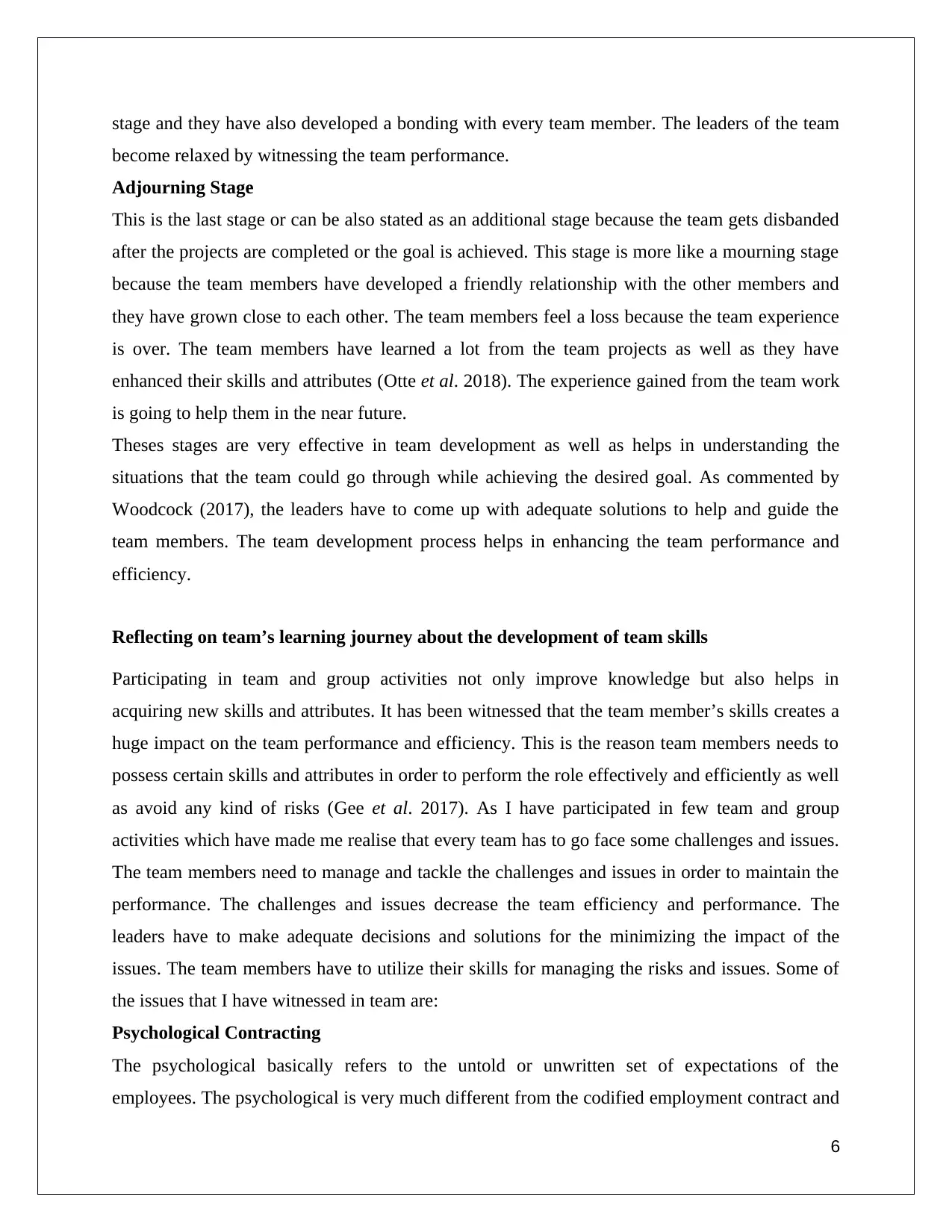
stage and they have also developed a bonding with every team member. The leaders of the team
become relaxed by witnessing the team performance.
Adjourning Stage
This is the last stage or can be also stated as an additional stage because the team gets disbanded
after the projects are completed or the goal is achieved. This stage is more like a mourning stage
because the team members have developed a friendly relationship with the other members and
they have grown close to each other. The team members feel a loss because the team experience
is over. The team members have learned a lot from the team projects as well as they have
enhanced their skills and attributes (Otte et al. 2018). The experience gained from the team work
is going to help them in the near future.
Theses stages are very effective in team development as well as helps in understanding the
situations that the team could go through while achieving the desired goal. As commented by
Woodcock (2017), the leaders have to come up with adequate solutions to help and guide the
team members. The team development process helps in enhancing the team performance and
efficiency.
Reflecting on team’s learning journey about the development of team skills
Participating in team and group activities not only improve knowledge but also helps in
acquiring new skills and attributes. It has been witnessed that the team member’s skills creates a
huge impact on the team performance and efficiency. This is the reason team members needs to
possess certain skills and attributes in order to perform the role effectively and efficiently as well
as avoid any kind of risks (Gee et al. 2017). As I have participated in few team and group
activities which have made me realise that every team has to go face some challenges and issues.
The team members need to manage and tackle the challenges and issues in order to maintain the
performance. The challenges and issues decrease the team efficiency and performance. The
leaders have to make adequate decisions and solutions for the minimizing the impact of the
issues. The team members have to utilize their skills for managing the risks and issues. Some of
the issues that I have witnessed in team are:
Psychological Contracting
The psychological basically refers to the untold or unwritten set of expectations of the
employees. The psychological is very much different from the codified employment contract and
6
become relaxed by witnessing the team performance.
Adjourning Stage
This is the last stage or can be also stated as an additional stage because the team gets disbanded
after the projects are completed or the goal is achieved. This stage is more like a mourning stage
because the team members have developed a friendly relationship with the other members and
they have grown close to each other. The team members feel a loss because the team experience
is over. The team members have learned a lot from the team projects as well as they have
enhanced their skills and attributes (Otte et al. 2018). The experience gained from the team work
is going to help them in the near future.
Theses stages are very effective in team development as well as helps in understanding the
situations that the team could go through while achieving the desired goal. As commented by
Woodcock (2017), the leaders have to come up with adequate solutions to help and guide the
team members. The team development process helps in enhancing the team performance and
efficiency.
Reflecting on team’s learning journey about the development of team skills
Participating in team and group activities not only improve knowledge but also helps in
acquiring new skills and attributes. It has been witnessed that the team member’s skills creates a
huge impact on the team performance and efficiency. This is the reason team members needs to
possess certain skills and attributes in order to perform the role effectively and efficiently as well
as avoid any kind of risks (Gee et al. 2017). As I have participated in few team and group
activities which have made me realise that every team has to go face some challenges and issues.
The team members need to manage and tackle the challenges and issues in order to maintain the
performance. The challenges and issues decrease the team efficiency and performance. The
leaders have to make adequate decisions and solutions for the minimizing the impact of the
issues. The team members have to utilize their skills for managing the risks and issues. Some of
the issues that I have witnessed in team are:
Psychological Contracting
The psychological basically refers to the untold or unwritten set of expectations of the
employees. The psychological is very much different from the codified employment contract and
6
Paraphrase This Document
Need a fresh take? Get an instant paraphrase of this document with our AI Paraphraser
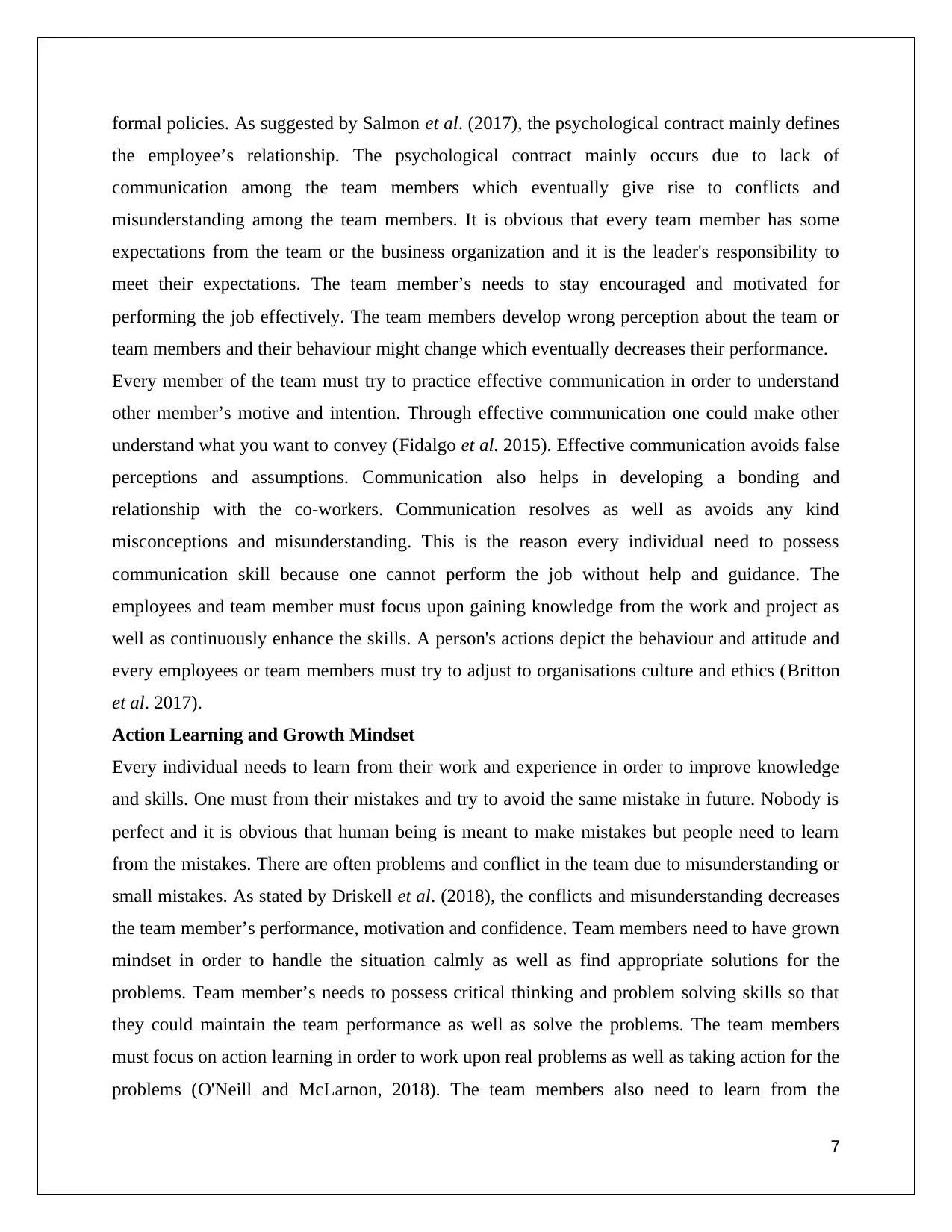
formal policies. As suggested by Salmon et al. (2017), the psychological contract mainly defines
the employee’s relationship. The psychological contract mainly occurs due to lack of
communication among the team members which eventually give rise to conflicts and
misunderstanding among the team members. It is obvious that every team member has some
expectations from the team or the business organization and it is the leader's responsibility to
meet their expectations. The team member’s needs to stay encouraged and motivated for
performing the job effectively. The team members develop wrong perception about the team or
team members and their behaviour might change which eventually decreases their performance.
Every member of the team must try to practice effective communication in order to understand
other member’s motive and intention. Through effective communication one could make other
understand what you want to convey (Fidalgo et al. 2015). Effective communication avoids false
perceptions and assumptions. Communication also helps in developing a bonding and
relationship with the co-workers. Communication resolves as well as avoids any kind
misconceptions and misunderstanding. This is the reason every individual need to possess
communication skill because one cannot perform the job without help and guidance. The
employees and team member must focus upon gaining knowledge from the work and project as
well as continuously enhance the skills. A person's actions depict the behaviour and attitude and
every employees or team members must try to adjust to organisations culture and ethics (Britton
et al. 2017).
Action Learning and Growth Mindset
Every individual needs to learn from their work and experience in order to improve knowledge
and skills. One must from their mistakes and try to avoid the same mistake in future. Nobody is
perfect and it is obvious that human being is meant to make mistakes but people need to learn
from the mistakes. There are often problems and conflict in the team due to misunderstanding or
small mistakes. As stated by Driskell et al. (2018), the conflicts and misunderstanding decreases
the team member’s performance, motivation and confidence. Team members need to have grown
mindset in order to handle the situation calmly as well as find appropriate solutions for the
problems. Team member’s needs to possess critical thinking and problem solving skills so that
they could maintain the team performance as well as solve the problems. The team members
must focus on action learning in order to work upon real problems as well as taking action for the
problems (O'Neill and McLarnon, 2018). The team members also need to learn from the
7
the employee’s relationship. The psychological contract mainly occurs due to lack of
communication among the team members which eventually give rise to conflicts and
misunderstanding among the team members. It is obvious that every team member has some
expectations from the team or the business organization and it is the leader's responsibility to
meet their expectations. The team member’s needs to stay encouraged and motivated for
performing the job effectively. The team members develop wrong perception about the team or
team members and their behaviour might change which eventually decreases their performance.
Every member of the team must try to practice effective communication in order to understand
other member’s motive and intention. Through effective communication one could make other
understand what you want to convey (Fidalgo et al. 2015). Effective communication avoids false
perceptions and assumptions. Communication also helps in developing a bonding and
relationship with the co-workers. Communication resolves as well as avoids any kind
misconceptions and misunderstanding. This is the reason every individual need to possess
communication skill because one cannot perform the job without help and guidance. The
employees and team member must focus upon gaining knowledge from the work and project as
well as continuously enhance the skills. A person's actions depict the behaviour and attitude and
every employees or team members must try to adjust to organisations culture and ethics (Britton
et al. 2017).
Action Learning and Growth Mindset
Every individual needs to learn from their work and experience in order to improve knowledge
and skills. One must from their mistakes and try to avoid the same mistake in future. Nobody is
perfect and it is obvious that human being is meant to make mistakes but people need to learn
from the mistakes. There are often problems and conflict in the team due to misunderstanding or
small mistakes. As stated by Driskell et al. (2018), the conflicts and misunderstanding decreases
the team member’s performance, motivation and confidence. Team members need to have grown
mindset in order to handle the situation calmly as well as find appropriate solutions for the
problems. Team member’s needs to possess critical thinking and problem solving skills so that
they could maintain the team performance as well as solve the problems. The team members
must focus on action learning in order to work upon real problems as well as taking action for the
problems (O'Neill and McLarnon, 2018). The team members also need to learn from the
7
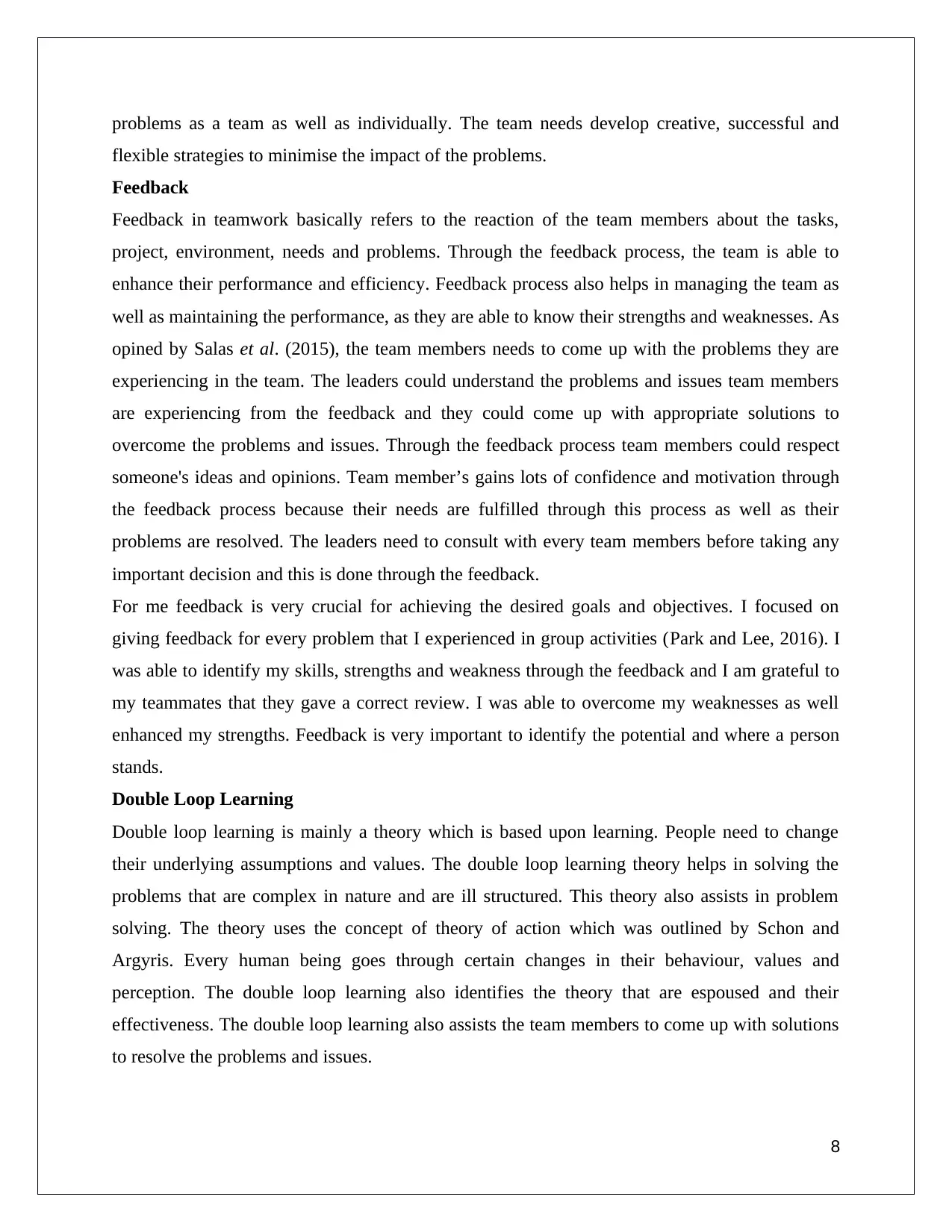
problems as a team as well as individually. The team needs develop creative, successful and
flexible strategies to minimise the impact of the problems.
Feedback
Feedback in teamwork basically refers to the reaction of the team members about the tasks,
project, environment, needs and problems. Through the feedback process, the team is able to
enhance their performance and efficiency. Feedback process also helps in managing the team as
well as maintaining the performance, as they are able to know their strengths and weaknesses. As
opined by Salas et al. (2015), the team members needs to come up with the problems they are
experiencing in the team. The leaders could understand the problems and issues team members
are experiencing from the feedback and they could come up with appropriate solutions to
overcome the problems and issues. Through the feedback process team members could respect
someone's ideas and opinions. Team member’s gains lots of confidence and motivation through
the feedback process because their needs are fulfilled through this process as well as their
problems are resolved. The leaders need to consult with every team members before taking any
important decision and this is done through the feedback.
For me feedback is very crucial for achieving the desired goals and objectives. I focused on
giving feedback for every problem that I experienced in group activities (Park and Lee, 2016). I
was able to identify my skills, strengths and weakness through the feedback and I am grateful to
my teammates that they gave a correct review. I was able to overcome my weaknesses as well
enhanced my strengths. Feedback is very important to identify the potential and where a person
stands.
Double Loop Learning
Double loop learning is mainly a theory which is based upon learning. People need to change
their underlying assumptions and values. The double loop learning theory helps in solving the
problems that are complex in nature and are ill structured. This theory also assists in problem
solving. The theory uses the concept of theory of action which was outlined by Schon and
Argyris. Every human being goes through certain changes in their behaviour, values and
perception. The double loop learning also identifies the theory that are espoused and their
effectiveness. The double loop learning also assists the team members to come up with solutions
to resolve the problems and issues.
8
flexible strategies to minimise the impact of the problems.
Feedback
Feedback in teamwork basically refers to the reaction of the team members about the tasks,
project, environment, needs and problems. Through the feedback process, the team is able to
enhance their performance and efficiency. Feedback process also helps in managing the team as
well as maintaining the performance, as they are able to know their strengths and weaknesses. As
opined by Salas et al. (2015), the team members needs to come up with the problems they are
experiencing in the team. The leaders could understand the problems and issues team members
are experiencing from the feedback and they could come up with appropriate solutions to
overcome the problems and issues. Through the feedback process team members could respect
someone's ideas and opinions. Team member’s gains lots of confidence and motivation through
the feedback process because their needs are fulfilled through this process as well as their
problems are resolved. The leaders need to consult with every team members before taking any
important decision and this is done through the feedback.
For me feedback is very crucial for achieving the desired goals and objectives. I focused on
giving feedback for every problem that I experienced in group activities (Park and Lee, 2016). I
was able to identify my skills, strengths and weakness through the feedback and I am grateful to
my teammates that they gave a correct review. I was able to overcome my weaknesses as well
enhanced my strengths. Feedback is very important to identify the potential and where a person
stands.
Double Loop Learning
Double loop learning is mainly a theory which is based upon learning. People need to change
their underlying assumptions and values. The double loop learning theory helps in solving the
problems that are complex in nature and are ill structured. This theory also assists in problem
solving. The theory uses the concept of theory of action which was outlined by Schon and
Argyris. Every human being goes through certain changes in their behaviour, values and
perception. The double loop learning also identifies the theory that are espoused and their
effectiveness. The double loop learning also assists the team members to come up with solutions
to resolve the problems and issues.
8
⊘ This is a preview!⊘
Do you want full access?
Subscribe today to unlock all pages.

Trusted by 1+ million students worldwide

The double loop learning helps the team members to change their personality and become more
committed towards the organisation and teams’ goals. This theory also enhances the team
member’s education. This theory helped me to enhance my leadership skills and attributes. I am
capable of guiding and managing a team only through this theory.
Conflict Management
The conflict management is mainly the ability to identify and handle the conflicts and problems
fairly, efficiently and sensibly. The team focuses on developing different strategies and
approaches to manage the conflicts. The main objective of the conflict management is to
enhance the group and learning outcomes as well as including the performance and effectiveness
of the team. The conflicts in teams are mainly caused due to misunderstandings and
misconceptions among the team members.
During one of the group activity, one of the team members came up with an idea and other
members appreciated the idea. The idea replaced the existing concept of the team which was
unbearable for one of the group member. This created conflict among two of the group members.
The other group members tried to resolve the issues but the situation became more intense. The
team had to come up with a strategy of using both the concepts in order to resolve the conflict.
The leaders of the team play a crucial role in developing strategies for managing the conflicts.
Conflicts are very likely to occur in teams and among team members but the leaders are
accountable to come up with strategies and solutions to resolve the problems. Conflicts decrease
the team performance and productivity and this is the reason conflicts needs to be managed and
solved.
Espoused Theories – Theories in Use
This is basically a model developed by Chris Argyris who was a Greek business theorist. This is
a model for reflections as well as evaluation. The model states that an individual need to evaluate
their actions and find the flaws. An individual could improve their personal and professional skill
through this model. An individual needs to implement changes in their attitude and behaviour in
order to adapt the organisation's culture and ethics. The model focuses upon learning and every
person must try to learn from their mistakes and try not to repeat the same mistake. Mistakes are
part of life and it is the people’s ability how well they can handle the mistakes (O'Neill and
Salas, 2018). People need to gain knowledge from everywhere as well as people's need to
enhance their skills in order to perform the work.
9
committed towards the organisation and teams’ goals. This theory also enhances the team
member’s education. This theory helped me to enhance my leadership skills and attributes. I am
capable of guiding and managing a team only through this theory.
Conflict Management
The conflict management is mainly the ability to identify and handle the conflicts and problems
fairly, efficiently and sensibly. The team focuses on developing different strategies and
approaches to manage the conflicts. The main objective of the conflict management is to
enhance the group and learning outcomes as well as including the performance and effectiveness
of the team. The conflicts in teams are mainly caused due to misunderstandings and
misconceptions among the team members.
During one of the group activity, one of the team members came up with an idea and other
members appreciated the idea. The idea replaced the existing concept of the team which was
unbearable for one of the group member. This created conflict among two of the group members.
The other group members tried to resolve the issues but the situation became more intense. The
team had to come up with a strategy of using both the concepts in order to resolve the conflict.
The leaders of the team play a crucial role in developing strategies for managing the conflicts.
Conflicts are very likely to occur in teams and among team members but the leaders are
accountable to come up with strategies and solutions to resolve the problems. Conflicts decrease
the team performance and productivity and this is the reason conflicts needs to be managed and
solved.
Espoused Theories – Theories in Use
This is basically a model developed by Chris Argyris who was a Greek business theorist. This is
a model for reflections as well as evaluation. The model states that an individual need to evaluate
their actions and find the flaws. An individual could improve their personal and professional skill
through this model. An individual needs to implement changes in their attitude and behaviour in
order to adapt the organisation's culture and ethics. The model focuses upon learning and every
person must try to learn from their mistakes and try not to repeat the same mistake. Mistakes are
part of life and it is the people’s ability how well they can handle the mistakes (O'Neill and
Salas, 2018). People need to gain knowledge from everywhere as well as people's need to
enhance their skills in order to perform the work.
9
Paraphrase This Document
Need a fresh take? Get an instant paraphrase of this document with our AI Paraphraser
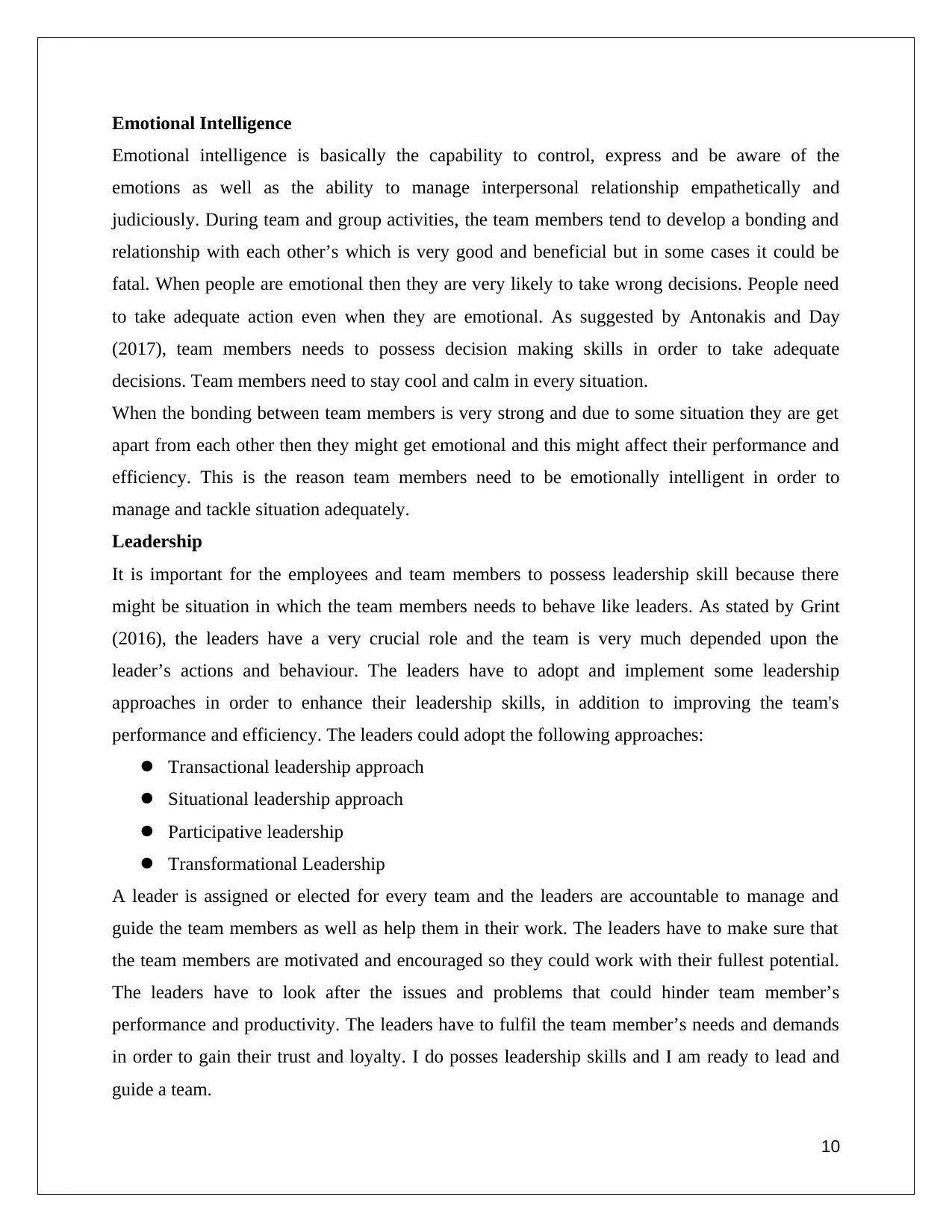
Emotional Intelligence
Emotional intelligence is basically the capability to control, express and be aware of the
emotions as well as the ability to manage interpersonal relationship empathetically and
judiciously. During team and group activities, the team members tend to develop a bonding and
relationship with each other’s which is very good and beneficial but in some cases it could be
fatal. When people are emotional then they are very likely to take wrong decisions. People need
to take adequate action even when they are emotional. As suggested by Antonakis and Day
(2017), team members needs to possess decision making skills in order to take adequate
decisions. Team members need to stay cool and calm in every situation.
When the bonding between team members is very strong and due to some situation they are get
apart from each other then they might get emotional and this might affect their performance and
efficiency. This is the reason team members need to be emotionally intelligent in order to
manage and tackle situation adequately.
Leadership
It is important for the employees and team members to possess leadership skill because there
might be situation in which the team members needs to behave like leaders. As stated by Grint
(2016), the leaders have a very crucial role and the team is very much depended upon the
leader’s actions and behaviour. The leaders have to adopt and implement some leadership
approaches in order to enhance their leadership skills, in addition to improving the team's
performance and efficiency. The leaders could adopt the following approaches:
Transactional leadership approach
Situational leadership approach
Participative leadership
Transformational Leadership
A leader is assigned or elected for every team and the leaders are accountable to manage and
guide the team members as well as help them in their work. The leaders have to make sure that
the team members are motivated and encouraged so they could work with their fullest potential.
The leaders have to look after the issues and problems that could hinder team member’s
performance and productivity. The leaders have to fulfil the team member’s needs and demands
in order to gain their trust and loyalty. I do posses leadership skills and I am ready to lead and
guide a team.
10
Emotional intelligence is basically the capability to control, express and be aware of the
emotions as well as the ability to manage interpersonal relationship empathetically and
judiciously. During team and group activities, the team members tend to develop a bonding and
relationship with each other’s which is very good and beneficial but in some cases it could be
fatal. When people are emotional then they are very likely to take wrong decisions. People need
to take adequate action even when they are emotional. As suggested by Antonakis and Day
(2017), team members needs to possess decision making skills in order to take adequate
decisions. Team members need to stay cool and calm in every situation.
When the bonding between team members is very strong and due to some situation they are get
apart from each other then they might get emotional and this might affect their performance and
efficiency. This is the reason team members need to be emotionally intelligent in order to
manage and tackle situation adequately.
Leadership
It is important for the employees and team members to possess leadership skill because there
might be situation in which the team members needs to behave like leaders. As stated by Grint
(2016), the leaders have a very crucial role and the team is very much depended upon the
leader’s actions and behaviour. The leaders have to adopt and implement some leadership
approaches in order to enhance their leadership skills, in addition to improving the team's
performance and efficiency. The leaders could adopt the following approaches:
Transactional leadership approach
Situational leadership approach
Participative leadership
Transformational Leadership
A leader is assigned or elected for every team and the leaders are accountable to manage and
guide the team members as well as help them in their work. The leaders have to make sure that
the team members are motivated and encouraged so they could work with their fullest potential.
The leaders have to look after the issues and problems that could hinder team member’s
performance and productivity. The leaders have to fulfil the team member’s needs and demands
in order to gain their trust and loyalty. I do posses leadership skills and I am ready to lead and
guide a team.
10

Use of team development models for boosting the performance
The Rocket team Performance Model
The rocket model is defined as the framework as well as the set of tools for boosting team
performance. It can be applied to develop the team dynamic and to serve the teams and leaders
with individual activities and tools to improve the performance of the team. The rocket model is
defined as the set of tools and framework for developing the performance of the team. It can be
applied to diagnose the team dynamics and to serve the leaders with different activities and tools
to improve the performance of the team. In the words of Lacerenzaet al. (2018), it was also
generated in relation to the request and questions from the manager's performance in
corporations all across the world. These models also involve the assessment of the team to
analyze the scores of the team on the Rocket Model Stages and serve the team with the sense of
the areas and strength for the improvement. The formation of the team gets off to an effective
start when the team members share a common focus on the contexts in which the leaders are
performing. As mentioned by Körneret al. (2016), it could be stated that being in a team is more
like being in a relationship because team members have to adjust with each other’s and neglect
their small mistakes. At this stage, there might be conflicts or misunderstanding among the team
members and the team leaders are accountable to resolve the misunderstanding and conflicts.
The team mostly understands that conflict management is not said to be the same as reducing the
conflict. The team members mostly cultivate the important courage to develop difficult problems
as per the development inefficient ways to the work through different disagreements as well as
find solutions.
11
The Rocket team Performance Model
The rocket model is defined as the framework as well as the set of tools for boosting team
performance. It can be applied to develop the team dynamic and to serve the teams and leaders
with individual activities and tools to improve the performance of the team. The rocket model is
defined as the set of tools and framework for developing the performance of the team. It can be
applied to diagnose the team dynamics and to serve the leaders with different activities and tools
to improve the performance of the team. In the words of Lacerenzaet al. (2018), it was also
generated in relation to the request and questions from the manager's performance in
corporations all across the world. These models also involve the assessment of the team to
analyze the scores of the team on the Rocket Model Stages and serve the team with the sense of
the areas and strength for the improvement. The formation of the team gets off to an effective
start when the team members share a common focus on the contexts in which the leaders are
performing. As mentioned by Körneret al. (2016), it could be stated that being in a team is more
like being in a relationship because team members have to adjust with each other’s and neglect
their small mistakes. At this stage, there might be conflicts or misunderstanding among the team
members and the team leaders are accountable to resolve the misunderstanding and conflicts.
The team mostly understands that conflict management is not said to be the same as reducing the
conflict. The team members mostly cultivate the important courage to develop difficult problems
as per the development inefficient ways to the work through different disagreements as well as
find solutions.
11
⊘ This is a preview!⊘
Do you want full access?
Subscribe today to unlock all pages.

Trusted by 1+ million students worldwide
1 out of 19
Related Documents
Your All-in-One AI-Powered Toolkit for Academic Success.
+13062052269
info@desklib.com
Available 24*7 on WhatsApp / Email
![[object Object]](/_next/static/media/star-bottom.7253800d.svg)
Unlock your academic potential
Copyright © 2020–2025 A2Z Services. All Rights Reserved. Developed and managed by ZUCOL.



